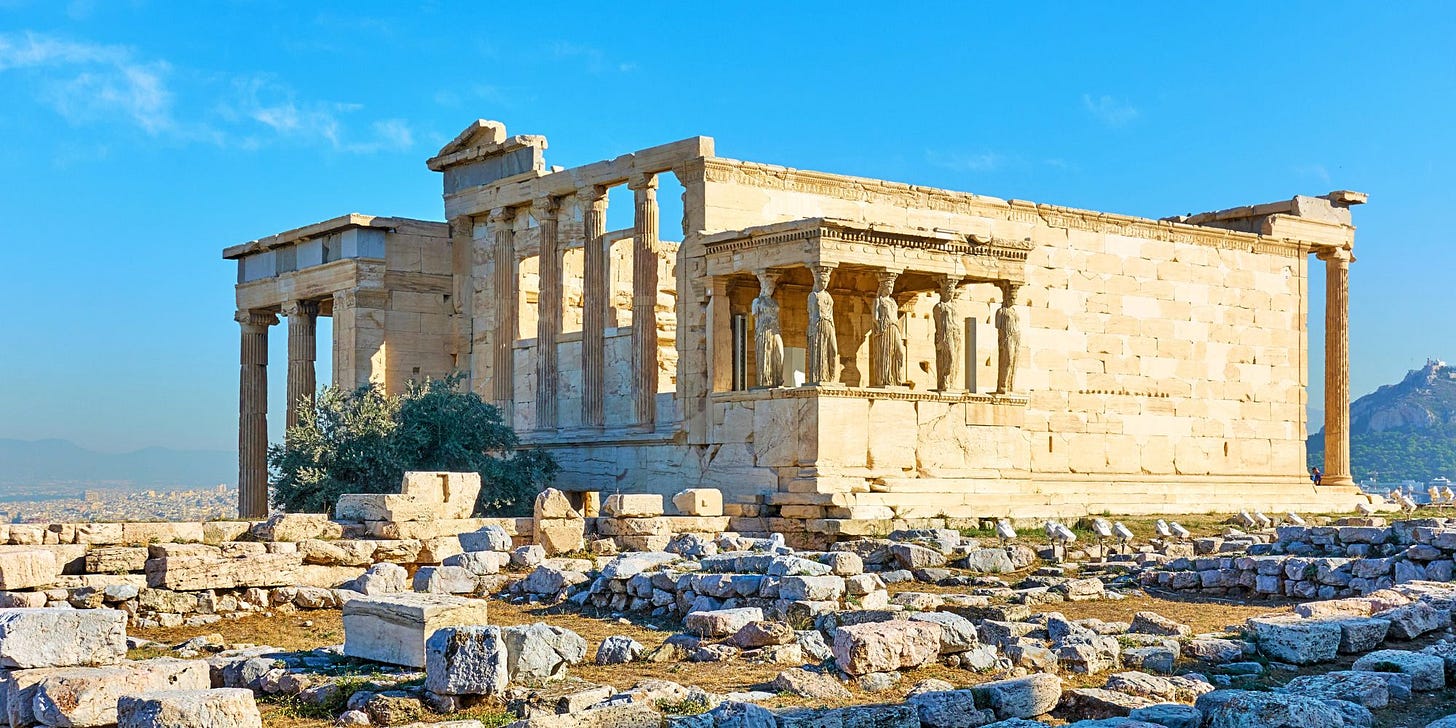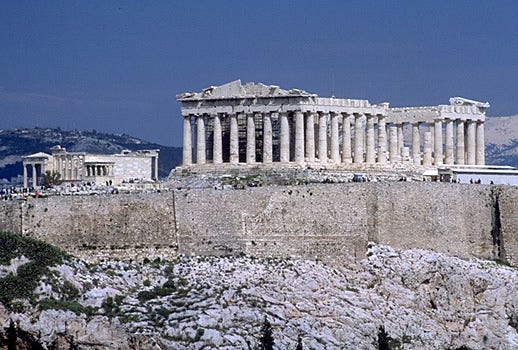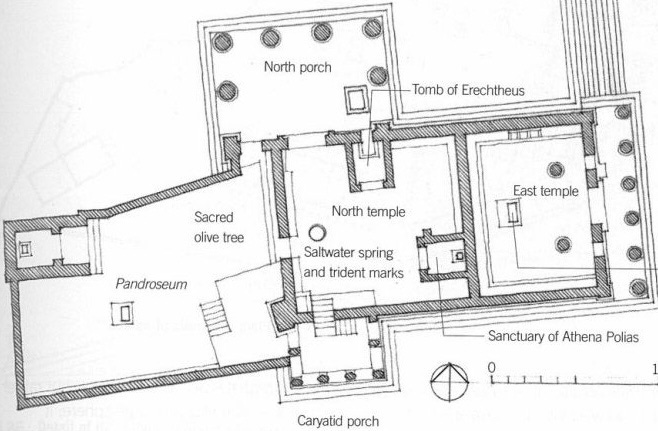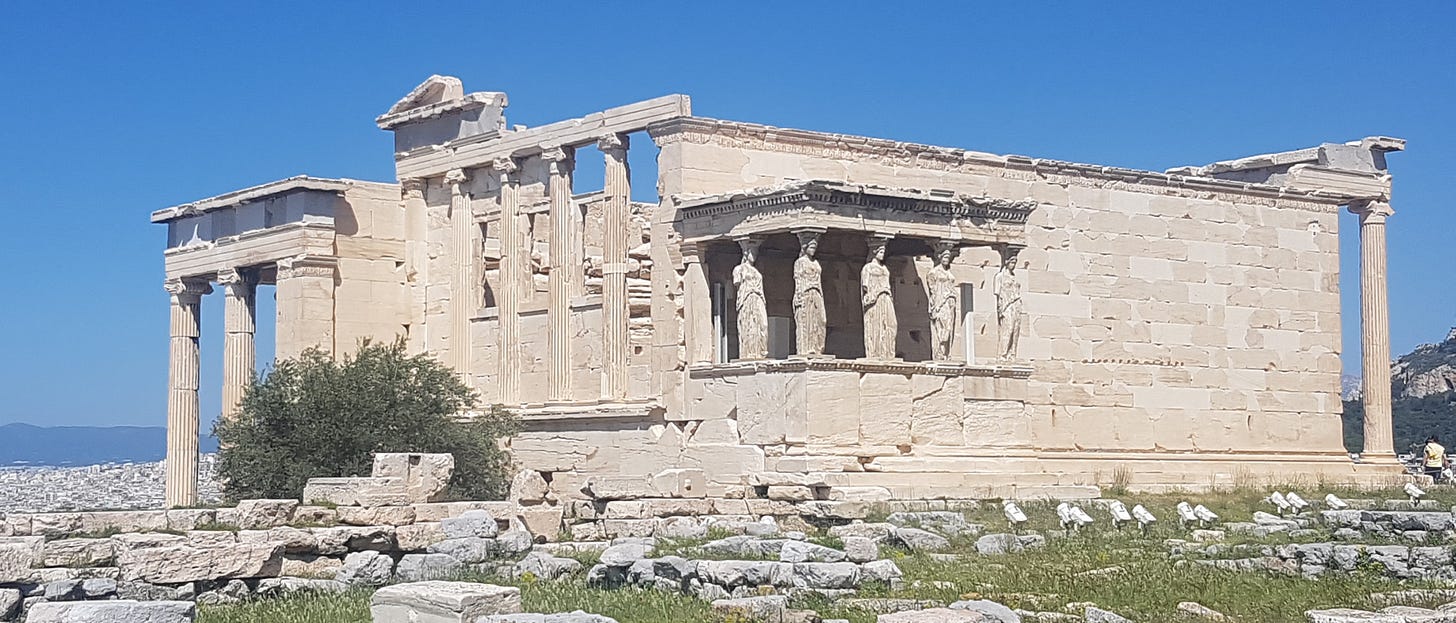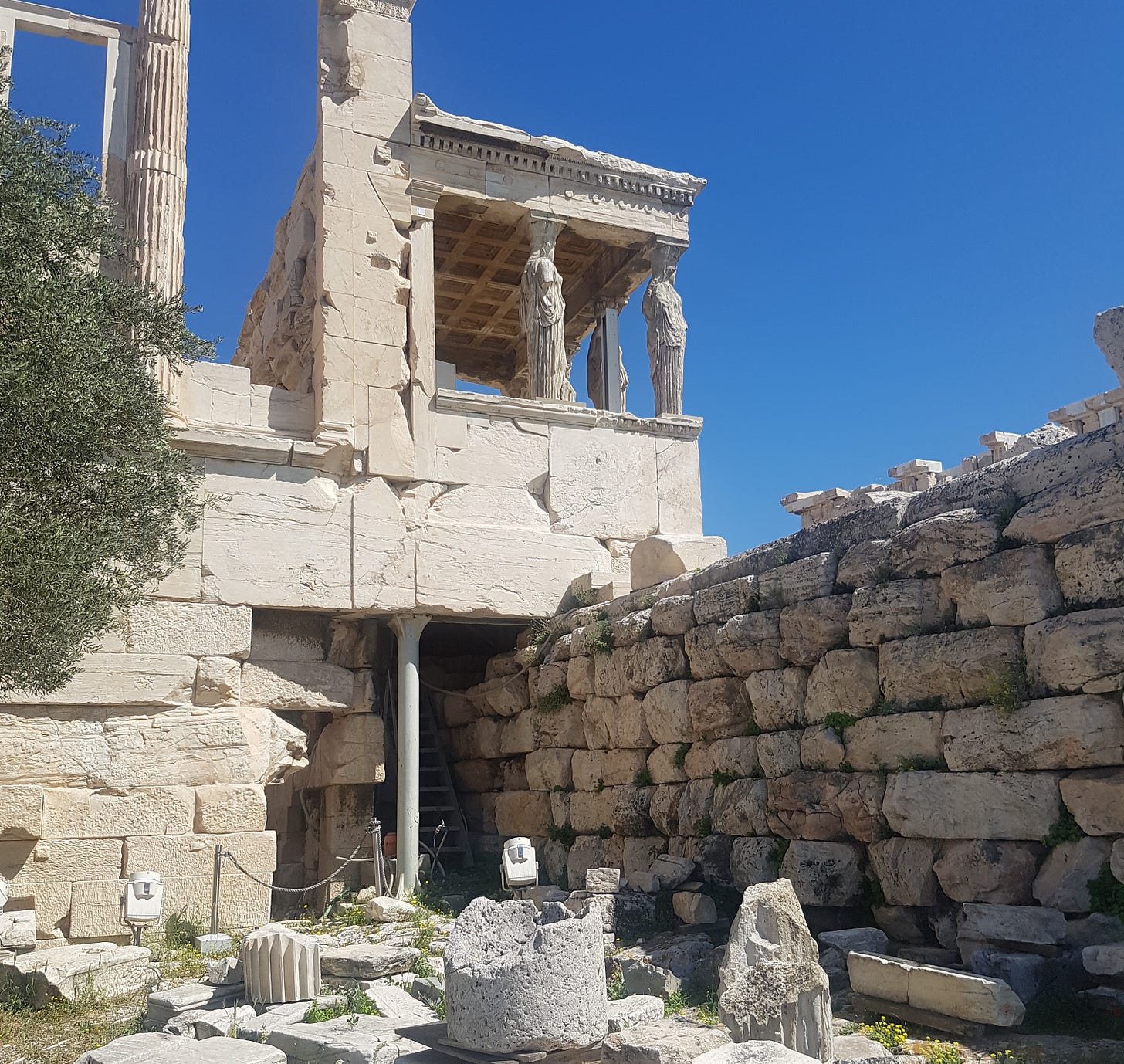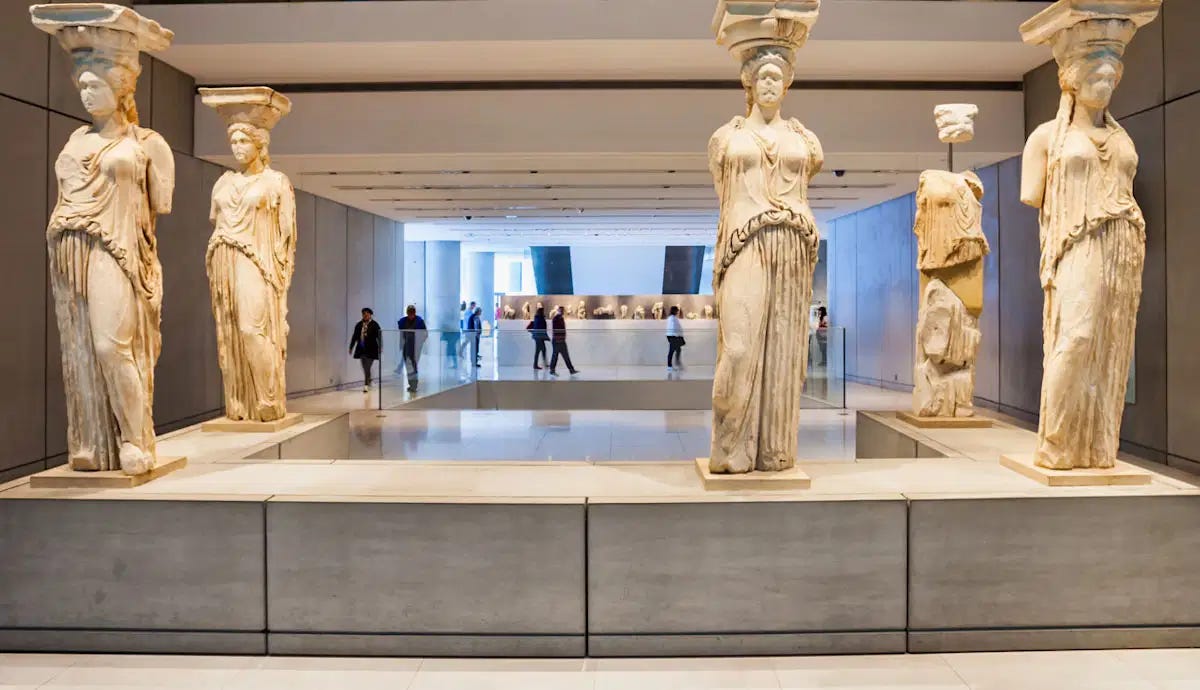An Ode to the Erechtheion
The gem hiding in the Parthenon's shadow
If you were to ask most people what their favourite surviving building from the Classical world is, I’m sure many people would extoll the virtues of the Parthenon, wonder at the majesty of the Colosseum or marvel at the awe-inspiring Pantheon. But for me, the most fantastic building from the Classical world sits right next to one of those wonders, so often neglected by tourists and students. It is the beautiful Erechtheion, a baffling construction that holds so many mysteries and presents such a unique picture of Athenian design and imagination. Today I would like to do it a little justice, so please read on!
Historical Context
Right let’s start with a bit of context around Athens and the Acropolis. The rocky citadel that was the heart of Athenian society was long considered a sacred site. What began as an easily defensible site for settlement later became a religious sanctuary, surrounded by huge cyclopean walls. From the Archaic period, Athenians began to erect temples on the site to their patron goddess Athena. The temple of Athena Polias and the Archaios Neos were both early attempts to honour her, and following the Battle of Marathon a much grander building was started, called the Parthenon. The Persian invasion of 480 BC, however, put an end to those plans as they sacked the city and destroyed the buildings on the Acropolis.
After the Greeks combined to repel Xerxes and, in this way, gained a greater sense of cultural superiority, it spurred in the Athenians a great desire to rebuild bigger and better. Spearheaded by the great strategos Pericles, a massive building programme saw the construction of the Propylaea (the gateway to the acropolis), the Parthenon (the one we know today), the temple of Athena Nike (victory, not the shoes) and most importantly, the Erechtheion. All of this was funded by Athenian imperial expansion; they used their leading status to form a protection racket of sorts with nearby smaller islands and poleis, all the while channeling the funds they extorted into glorifying their own city with these buildings… but hey, it still looks cool today!
Why not the Parthenon?
Much can and has been said about how perfect the Parthenon is. It is massive, imposing, symmetrical, dominant. It is everything Pericles wanted to say about himself and his polis. The brilliant mathematical design, the expert carving, the optical illusions, the extensive relief carvings - look, it is fantastic. If it weren’t for some dodgy storing of ammunition, it would also be in even better condition today. But the reason I love the Erechtheion more is precisely because it is everything that the Parthenon isn’t. It isn’t perfect, it isn’t massive, it didn’t get the big broad platform to rest on, and all the attention from people past and present. The Erechtheion is the younger sibling of the Acropolis and it deserves its time in the sun.
The Unique Challenges of the Erechtheion
What is the Erechtheion anyway? Well that name is a nickname, based on the legendary founder of Athens, Erechtheus. It can also be referred to as the temple of Athena Polias, as it housed the life-size olive-wood statue of Athena that had resided in previous iterations of the building. It may also have housed the sanctuary of Poseidon, as well as many other interesting religious items and locations (including possibly a snake pit!) It’s a bit of everything, which is what gives it such unique charm.
What makes it even more special is its location on the Acropolis. Once built, the Parthenon dominated the free space on this outcrop, which was by no means completely flat, leaving very little room for new buildings. Furthermore, the ruins of the Archaios Neos, the Old Temple of Athena, were to be left undisturbed as a memorial of sorts to the Persian invasion. What remained was a small space near the northern side of the site, where the hill sloped downwards quite steeply. This is about as far away from an ideal site as you can get. You can imagine that a massive stone temple needs to rest on a flat, broad site - yet they chose the complete opposite. And to accommodate all of this, it led to one of the most unique designs in classical architecture.
Looking at the plan above, you can see that the layout of the temple is by no means ordinary. Whereas the Parthenon is a very regular rectangle surrounded by columns, with a porch at each end, the Erechtheion is anything but regular. This was first of all a result of the ground level. The East end is at the highest point, but the ground slopes down both to the North and to the West. As a result, they could not put a porch at the West end, where it should have been. Instead, they swung the western porch around to the North, where it sits on the lowest point of ground. In order to keep the roof relatively even across the whole building, this North porch has much taller columns than the East. They utilised the more slender ionic style columns to fit with this.
Now that solves the porch problem - or does it? Greek architects loved symmetry, and having one porch stuck to the side looked horrible. Therefore the only option was to add another porch on the opposite side, to the south. Now because this porch was higher up, it was quite short and couldn’t fit regular columns. Therefore, they went with a special type of column made of female statue figures, known as Karyatids. These are the most well-known part of the building, for their striking beauty. Because this side is visible from the centre of the Acropolis and from the Parthenon, it made sense for this most beautiful feature to be visible too.
Now we have a T shaped temple with lower and upper porches at the western end, and a regular appearance at the East. The West wall was also very tall to accomodate the high ceiling, and they added fake columns to the wall to give some semblance of normality to the building. However, there was another feature to accommodate now - the sacred Olive Tree of Athena which had been growing on the site since time immemorial. It stood for the symbolic gift of Athena in the ‘contest’ for patronage of the city (a scene depicted on the Parthenon) and, although not the original, a tree stands in a very similar place there today. As it was growing near the western end, to brighten up the area they built a sanctuary around it which connected to other structures on the Acropolis.
What’s the End Result?
Well, when you put it all together, you get an incredible building. It’s a life-changing experience to visit and explore it, and sadly so many tourists only give it a casual glance! Each side of the building opens up a completely different aspect, a unique appearance and more mysteries to unravel. While it would also have featured bright paints and metal decorations, it is still remarkable to behold today. It remains a site of great mystery as to just what each part was used for, which items or rituals were held there, and there are more myths and legends that go with it - spots where Poseidon’s trident or Zeus’ lightning bolt may have struck down Erechtheus, the snake pit where Cecrops lived as a serpent before turning into a man, and so many more.
The Erechtheion is a building that raises more questions than it answers. It is still in great condition considering what the location has been through these past 2,500 years. The Karyatids at the site are copies, although all but one are easily visible in the nearby Acropolis Museum. The last one, sadly, was stolen by Lord Elgin when he overreached his incredibly tenuous permission from the occupying Ottomans to remove some elements from the site - more on that elsewhere - and now sits alone at the British Museum, waiting to return home.
Have you visited the Acropolis? Seen this wonderful building? Or want to share your thoughts on your favourite classical structure? Leave a comment and share with your friends! Thanks again, see you next time!


